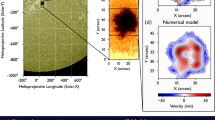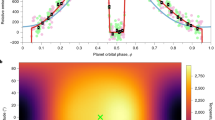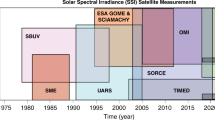Abstract
High sensitivity Doppier spectroscopy of integral sunlight in the 769.9 nm line of neutral potassium reveals several equally spaced lines of Q > 1,000 centred on the well known period of 5 min. These lines are interpreted as low l, high n overtones of the entire Sun and, if viewed in terms of current solar models, appear to imply a low heavy element abundance and a consequent low solar neutrino flux. Previous workers1–3 have used spatial resolution to study the 5-min oscillation of the solar photosphere and have shown that power is concentrated along narrow ridges in the k, w diagram. These oscillations are mainly low n, high l value acoustic modes of the entire Sun. In contrast to this, the present work (for a summary see ref. 4) is aimed at an overall view of the solar surface and consequently is biased to a study of low l value oscillations. These modes penetrate deeply5 and thus probe the structure as well as the interior angular velocity of the Sun6.
This is a preview of subscription content, access via your institution
Access options
Subscribe to this journal
Receive 51 print issues and online access
$199.00 per year
only $3.90 per issue
Buy this article
- Purchase on Springer Link
- Instant access to full article PDF
Prices may be subject to local taxes which are calculated during checkout
Similar content being viewed by others
References
Deubner, F.-L. Solar Phys. 44, 371 (1975).
Rhodes, Jr, E. J., Ulrich, R. K. & Simon, G. W. Astrophys. J. 218, 521 (1977).
Deubner, F.-L., Ulrich, R. K. & Rhodes, E. J. Jr Astr. Astrophys. 72, 177–185 (1979).
Gough, D. O. Nature 278, 685–686 (1979).
Wolff, C. L. Solar Phys. 32, 31 (1973).
Brookes, J. R., Isaak, G. R. & van der Raay, H. B. Nature 259, 92–95 (1976).
Iben, I. & Mahaffy, J. Astrophys. J. 209, L39–L43 (1976).
Christensen-Dalsgaard, J., Gough, D. O. & Morgan, J. G. Astr. Astrophys. 73, 121–128 (1979).
Davis, R. Jr, Evans, J. C. & Cleveland, B. T. Purdue Univ. Conf. Proc., 53, 65 (1978).
Brookes, J. R., Isaak, G. R. & van der Raay, H. B. Mon. Not. R. astr. Soc. 185, 1–17 (1978).
Blackman, R. B. & Tukey, J. W. The Measurement of Power Spectra (Dover, New York, 1958).
Hill, H. A. The New Solar Physics (ed. Eddy, J. A.) 162 (Westview, Boulder, Colorado, 1978).
Brookes, J. R., Isaak, G. R. & van der Raay, H. B. Mon. Not. R. astr. Soc. 185, 19–22 (1978).
Ledoux, P. Astrophys. J. 114, 373–384 (1951).
Author information
Authors and Affiliations
Rights and permissions
About this article
Cite this article
Claverie, A., Isaak, G., McLeod, C. et al. Solar structure from global studies of the 5-minute oscillation. Nature 282, 591–594 (1979). https://doi.org/10.1038/282591a0
Received:
Accepted:
Issue Date:
DOI: https://doi.org/10.1038/282591a0
This article is cited by
-
The Privileged Life of a Theoretical Observer
Solar Physics (2022)
-
Solar structure and evolution
Living Reviews in Solar Physics (2021)
-
Performance of the Birmingham Solar-Oscillations Network (BiSON)
Solar Physics (2016)
-
Global seismology of the Sun
Living Reviews in Solar Physics (2016)
-
The Solar-Stellar Connection
Space Science Reviews (2015)
Comments
By submitting a comment you agree to abide by our Terms and Community Guidelines. If you find something abusive or that does not comply with our terms or guidelines please flag it as inappropriate.



